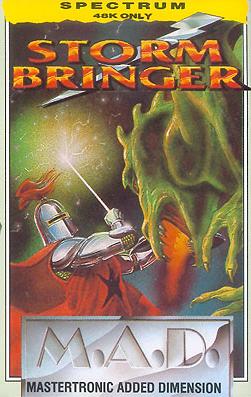
The Great Giana Sisters is a platform game developed by the West German company Time Warp and published by Rainbow Arts in 1987 for various home computers such as the Commodore 64, Amiga and Atari ST. Players control Giana, or her sister Maria in the multiplayer mode, to explore a magical world inside their dreams. The two seek out a giant diamond to awaken from their dream. They traverse side-scrolling stages while avoiding hazards such as monsters and other enemies with the aid of power-ups grant them various abilities such as firing projectiles and making enemies fall asleep.

Shinobi (忍) is a side-scrolling hack and slash video game produced by Sega, originally released for arcades on the Sega System 16 board in 1987. The player controls ninja Joe Musashi, to stop the Zeed terrorist organization from kidnapping students of his clan.

Wonder Boy in Monster Land, known by its original arcade release as Wonder Boy: Monster Land, is a platform video game developed by Westone Bit Entertainment and released by Sega in Japanese arcades in 1987 and for the Master System in 1988, with a number of other home computer and console ports following. The game is the sequel to the 1986 game Wonder Boy and takes place eleven years after the events in the previous game. After enjoying over a decade of peace on Wonder Land following the defeat of the evil King by Tom-Tom, later bestowed the title "Wonder Boy", a fire-breathing dragon called the MEKA dragon appeared; he and his minions conquered Wonder Land, turning it into "Monster Land". The people, helpless due to their lack of fighting skill, call for Wonder Boy, now a teenager, to destroy the monsters and defeat the MEKA dragon. Players control Wonder Boy through twelve linear levels as he makes his way through Monster Land to find and defeat the MEKA dragon. Players earn gold by defeating enemies and buy weapons, armor, footwear, magic, and other items to help along the way.

Pitfall! is a video game developed by David Crane for the Atari 2600 and released in 1982 by Activision. The player controls Pitfall Harry, who has a time limit of 20 minutes to seek treasure in a jungle. The game world is populated by enemies and hazards that variously cause the player to lose lives or points.

Knight Lore is a 1984 action-adventure game developed and published by Ultimate Play the Game, and written by company founders Chris and Tim Stamper. The game is known for its use of isometric graphics, which it further popularized in video games. In Knight Lore, the player character Sabreman has forty days to collect objects throughout a castle and brew a cure to his werewolf curse. Each castle room is depicted in monochrome on its own screen and consists of blocks to climb, obstacles to avoid, and puzzles to solve.
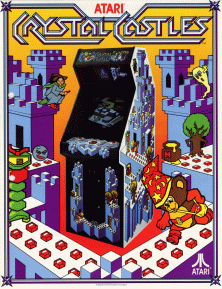
Crystal Castles is an arcade game released by Atari, Inc. in 1983. The player controls Bentley Bear who has to collect gems located throughout trimetric-projected rendered castles while avoiding enemies, some of whom are after the gems as well.

Conquests of Camelot: The Search for the Grail is a graphic adventure game released in 1990 by Sierra On-Line. It was the first game in the Conquests series designed by Christy Marx and her husband Peter Ledger. The only other game in the series was 1991's Conquests of the Longbow: The Legend of Robin Hood. Marx did the majority of the design work while Ledger created the game and package art.

Double Dragon is a 1987 beat 'em up video game developed by Technōs Japan and distributed by Taito for arcades across Asia, North America and Europe. It is the first title in the Double Dragon franchise. The game's development was led by Yoshihisa Kishimoto, and it is a spiritual and technological successor to Technos' earlier beat 'em up, Nekketsu Kōha Kunio-kun (1986), released outside of Japan by Taito as Renegade; Kishimoto originally envisioned it as a direct sequel and part of the Kunio-kun series, before making it a new game with a different cast and setting.
Magic Knight is a computer game franchise created by freelance programmer David Jones originally for the 1985 game Finders Keepers on the Mastertronic budget label. Finders Keepers is a flip-screen platform game released on the ZX Spectrum, Amstrad CPC, MSX and Commodore 64. The game spawned three additional sequels on the Mastertronic Added Dimension budget label: Spellbound (1985), Knight Tyme (1986) and Stormbringer (1987). The three sequels are far less action-orientated, being effectively graphic adventure games using a basic menu system ("Windimation") for Magic Knight to interact with characters and items instead of typed commands.
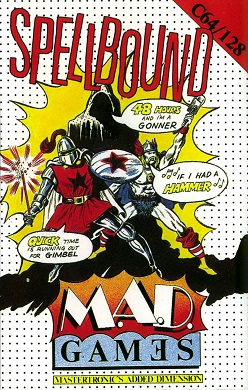
Spellbound is a video game that was designed and programmed by David Jones with music by Rob Hubbard and released in 1985 for the ZX Spectrum and Amstrad CPC home computers. Versions for the Commodore 64 and the Atari 8-bit computers and an enhanced 128K Spectrum version with music and additional graphics were all released in 1986. Unlike the other Magic Knight games, Spellbound was never released for the MSX system back in 1985, but an authorized version was finally released by Tracy Lewis in 2023. It is the second game in the Magic Knight series and was published by Mastertronic as part of their Mastertronic Added Dimension label.
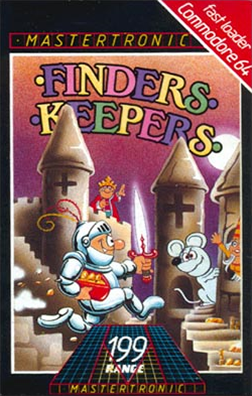
Finders Keepers is a video game written by David Jones and the first game in the Magic Knight series. It was published on the Mastertronic label for the ZX Spectrum, Amstrad CPC, MSX, Commodore 64, and Commodore 16 in 1985. Published in the United Kingdom at the budget price of £1.99. Finders Keepers is a platform game with some maze sections.

Knight Tyme is a computer game released for the ZX Spectrum, Amstrad CPC, Commodore 64 and MSX compatibles in 1986. It was published by Mastertronic as part of their Mastertronic Added Dimension label. Two versions of the ZX Spectrum release were published: a full version for the 128K Spectrum and a cut-down version for the 48K Spectrum that removed the music, some graphics and some locations.

Universal Hero is an action-adventure game released by Mastertronic in 1986 for the ZX Spectrum and in 1987 for the Atari 8-bit family. The Spectrum version was developed by Stuart Middleton working under the name of Xcel Software. The Atari 8-bit port was commissioned by Mastertronic from a third-party developer.

Indiana Jones and the Last Crusade: The Action Game was published in 1989 by Lucasfilm Games, based on the film of the same name. The game was released for the ZX Spectrum, Amstrad CPC, Commodore 64, Atari ST, Amiga, IBM PC, MSX, Master System, NES, Game Boy, Sega Genesis and Game Gear.

Feud is an adventure game designed by John Pickford for Binary Design and published in 1987 as the first game under the Bulldog Software label of Mastertronic. Versions were released for the Amiga, Amstrad CPC, Atari 8-bit family, Atari ST, Commodore 64, MS-DOS, MSX, and ZX Spectrum. The player takes on the role of the sorcerer Learic, and must fight his evil twin Leanoric.
David Jones is a former freelance computer game programmer who was prolific in the mid-to-late 1980s. He is best known for the creation of the cult computer game character Magic Knight in his 1985 game Finders Keepers for the Mastertronic budget label and released on the ZX Spectrum, Amstrad CPC, MSX and Commodore 64. He later went on to work for Psygnosis and Acclaim.
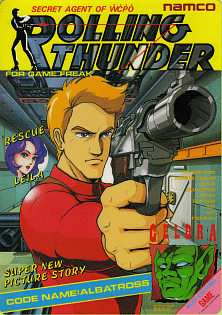
Rolling Thunder is a run and gun video game developed by Namco in Japan and Europe and released in 1986 as a coin-operated arcade video game using the Namco System 86 hardware. It was distributed in North America by Atari Games. The player takes control of a secret agent who must rescue his female partner from a terrorist organization. Rolling Thunder was a commercial success in arcades, and it was released for various home computer platforms in 1987 and the Nintendo Entertainment System in 1989. The original arcade game has been included in various classic game compilations as well. It influenced later arcade action franchises such as Shinobi and Time Crisis, which borrowed mechanics such as taking cover behind crates.
The English Software Company, later shortened to English Software, was a Manchester, UK-based video game developer and publisher that operated from 1982 until 1987. Starting with its first release, the horizontally scrolling shooter Airstrike, English Software focused on the Atari 8-bit family of home computers, then later expanded onto other platforms. The company used the slogan "The power of excitement".

Ninja is a beat 'em up game developed by Sculptured Software and released by Mastertronic in 1986 for the Atari 8-bit family, Commodore 64, and ZX Spectrum, then in 1987 for the Amstrad CPC, Amiga, Atari ST, and MS-DOS. An arcade version of the game was released in 1987 for Mastertronic's Arcadia Systems which is based on Amiga hardware. The Amiga, Atari ST, and Arcade versions were released as Ninja Mission. As a Ninja, the player attacks a fortress made of individual fixed screens which can be explored non-linearly.

Judge Dredd is a 1991 platform shoot 'em up video game based on the character of the same name. It was developed by Random Access and published by Virgin Mastertronic. It was released in Europe in 1991, for the Amiga, Atari ST, Commodore 64, and ZX Spectrum. Critics found the gameplay repetitive.
